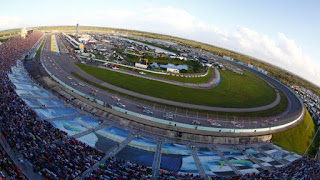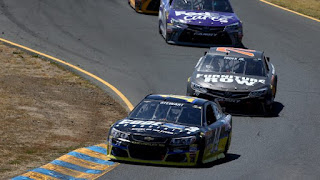DAYTONA BEACH, Fla. – In becoming the most decorated Millennial in NASCAR history, it never seems easy for Brad Keselowski – even just garnering credit when he makes it seem remarkably easy on track.
That’s been the recurring theme lately for the Team Penske star in the restrictor-plate bedlam of Daytona International Speedway and Talladega Superspeedway. Keselowski’s victory in Saturday’s Coke Zero 400 was his second straight on the tracks that choke down horsepower and create massive packs – requiring deft navigation of its capricious draft at 200 mph – and his improvement curve seems to be accelerating.
He led a race-high 115 of 161 laps at Daytona, bettering his previous plate track high of 46 laps led in May at Talladega.
In both races, he took the lead with 16 laps to go and coolly dictated the rhythm and tone on mammoth ovals whose sound and fury allegedly can’t be harnessed.
Of course, he has exhibited a flair for the dramatic, too. In the fifth start of his Cup career – and his first in a part-time, underfunded car that was blessed with a Hendrick Motorsports engine but little in the way of manpower – Keselowski outdueled a host of veterans by gamely holding the bottom lane and launching Carl Edwards into the catchfence at Talladega. The first lap he led in his Sprint Cup career was the last that day on the 2.66-mile oval.
His next two wins at Talladega – a jaw-dropping maneuver that snookered Kyle Busch in 2012 and a last-lap pass of Ryan Newman during a must-win playoff race to advance in 2014 – were just as compelling and helped bolster an inescapable conclusion.
Keselowski currently might be the world’s best plate racer, and one number bears it out nicely.
Since 2009, he has more plate victories (five) than any driver in NASCAR’s premier series.
Ahh, but it’s not so simple for some.
Just peruse the musings from the angst-ridden peanut gallery of NASCAR social media since Saturday night.
Stating the abundantly obvious – that having the most wins in the past seven years at Daytona and Talladega might merit some measure of praise – was cast as hyperbolic trolling of Keselowski’s mastery.
How can you label someone the best solely based on the number of times they finished first?
The reaction isn’t entirely unpredictable given that Keselowski has been a target of fans’ boos for several years.
It could be construed as a byproduct of the 2012 Sprint Cup champion’s hard-nosed and indefatigable will. Respect among fans and peers always has seemed elusive for the Rochester Hills, Mich., native.
While establishing himself as a rising star, he butted heads with Tony Stewart, Denny Hamlin and Kyle Busch. It didn’t subside much after he won the 2012 championship, though the clashes became less frequent and vocal. Keselowski was elected to the Sprint Cup Drivers Council, but he won’t win popularity contests in many quarters of the industry.
That doesn’t explain all of why Kez has been denied his due for plate greatness, though.
Here are some reasons why:
–He’s threatening the supremacy of a 13-time most popular driver: In 2015, Dale Earnhardt Jr., who leads active drivers with 10 restrictor-plate wins, posted two wins, a second and a third between Daytona and Talladega. But he is having arguably the worst plate season of his career. After crashing in the Daytona 500 and at Talladega, Earnhardt finished a nondescript 21st Saturday while battling the same handling problems plaguing the No. 88 Chevrolet in 2016 plate races.
Keselowski’s rise hasn’t come at Earnhardt’s expense, but there are mitigating factors that make it less palatable for Junior Nation to accept. Earnhardt gave Keselowski his big break by putting him in a JRM Xfinity ride a decade ago. Since then, he’s won a Cup championship, which Earnhardt still doesn’t have.
Plate greatness has been a constant through the ups and downs of Earnhardt’s career. If Keselowski were perceived as snatching it, Earnhardt’s fervent following wouldn’t take kindly.
–His success has come in one of the oddest eras of plate racing: None of Keselowski’s victories came during the 2011 season that featured the wretched rise (and fall) of tandem drafting, but the taint still lingered.
Plate racing went through a bizarre spell during that period, and the interruption in continuity made an impact on how the racing was celebrated.
Keselowski’s winning stretch would be more appreciated if it had occurred in the early to mid-2000s, when the rules for plate racing were in a sweet spot that engendered decent racing while emphasizing driver talent (see: Earnhardt’s winning run at Talladega in 2001-04).
–He has taken advantage of depleted fields: The most specious of narratives, driven mostly by the 22-car wreck Saturday at Daytona – while conveniently omitting that it didn’t eliminate every legitimate contender. Keselowski still had to make a nifty move to take the lead from Busch (ranked first in driver rating at Daytona among active Cup drivers) as well as beat 2016 Daytona 500 winner Denny Hamlin, restrictor-plate sleeper Kurt Busch and others.
There also was a 21-car wreck in May at Talladega, a 10-car wreck in 2014, two nine-car wrecks in 2012 and a 14-car and 10-car wreck in 2009.
Yes, massive pileups have happened in all of Keselowski’s victories. Generally, they occur in the middle of the pack, wiping out mostly cars that weren’t a serious threat to start.
–He initially struggled at Daytona: Going strictly by the numbers (which always is a dangerous trap in analyzing plate results), Keselowski’s results have lagged at the World Center of Racing. The 2.5-mile track is his worst in Sprint Cup based on average finish (20.7).
But a closer examination shows he already has been headed in the right direction. He unquestionably was mediocre at the 2016 Daytona 500 (20th), prompting his team to construct a much sleeker No. 2 Ford for this past weekend, but aside from that, he has been strong the past three seasons.
He was running well last July before a mid-race wreck, he was contending in the top five of the 2015 Daytona 500 before a late engine failure, and he finished third in the 2014 Daytona 500 – delivering the winning push to Earnhardt in the two-lap dash to the finish.





















